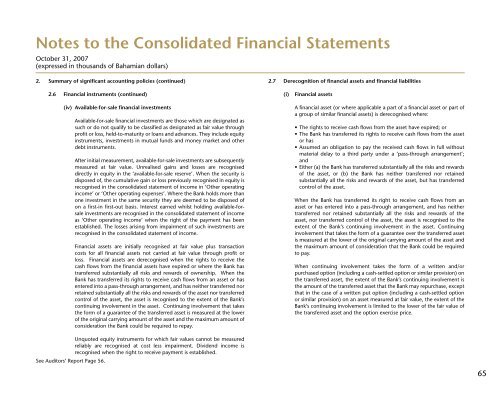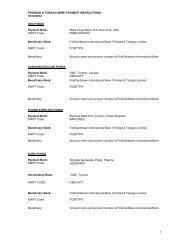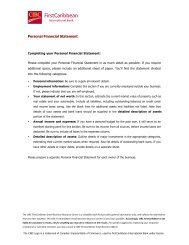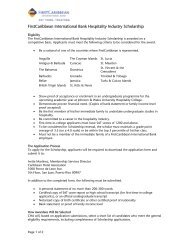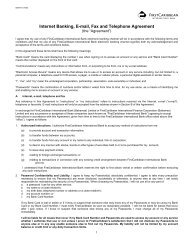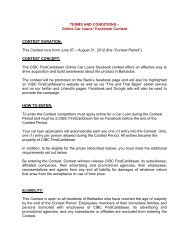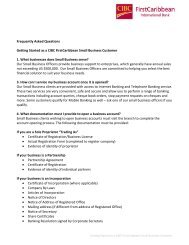Bahamas - FirstCaribbean International Bank
Bahamas - FirstCaribbean International Bank
Bahamas - FirstCaribbean International Bank
Create successful ePaper yourself
Turn your PDF publications into a flip-book with our unique Google optimized e-Paper software.
Notes to the Consolidated Financial Statements<br />
October 31, 2007<br />
(expressed in thousands of Bahamian dollars)<br />
2. Summary of significant accounting policies (continued)<br />
2.7 Derecognition of financial assets and financial liabilities<br />
2.6 Financial instruments (continued)<br />
(iv) Available-for-sale financial investments<br />
Available-for-sale financial investments are those which are designated as<br />
such or do not qualify to be classified as designated as fair value through<br />
profit or loss, held-to-maturity or loans and advances. They include equity<br />
instruments, investments in mutual funds and money market and other<br />
debt instruments.<br />
After initial measurement, available-for-sale investments are subsequently<br />
measured at fair value. Unrealised gains and losses are recognised<br />
directly in equity in the ‘available-for-sale reserve’. When the security is<br />
disposed of, the cumulative gain or loss previously recognised in equity is<br />
recognised in the consolidated statement of income in ‘Other operating<br />
income’ or ‘Other operating expenses’. Where the <strong>Bank</strong> holds more than<br />
one investment in the same security they are deemed to be disposed of<br />
on a first-in first-out basis. Interest earned whilst holding available-forsale<br />
investments are recognised in the consolidated statement of income<br />
as ‘Other operating income’ when the right of the payment has been<br />
established. The losses arising from impairment of such investments are<br />
recognised in the consolidated statement of income.<br />
Financial assets are initially recognised at fair value plus transaction<br />
costs for all financial assets not carried at fair value through profit or<br />
loss. Financial assets are derecognised when the rights to receive the<br />
cash flows from the financial assets have expired or where the <strong>Bank</strong> has<br />
transferred substantially all risks and rewards of ownership. When the<br />
<strong>Bank</strong> has transferred its rights to receive cash flows from an asset or has<br />
entered into a pass-through arrangement, and has neither transferred nor<br />
retained substantially all the risks and rewards of the asset nor transferred<br />
control of the asset, the asset is recognised to the extent of the <strong>Bank</strong>’s<br />
continuing involvement in the asset. Continuing involvement that takes<br />
the form of a guarantee of the transferred asset is measured at the lower<br />
of the original carrying amount of the asset and the maximum amount of<br />
consideration the <strong>Bank</strong> could be required to repay.<br />
(i)<br />
Financial assets<br />
A financial asset (or where applicable a part of a financial asset or part of<br />
a group of similar financial assets) is derecognised where:<br />
• The rights to receive cash flows from the asset have expired; or<br />
• The <strong>Bank</strong> has transferred its rights to receive cash flows from the asset<br />
or has<br />
• Assumed an obligation to pay the received cash flows in full without<br />
material delay to a third party under a ‘pass-through arrangement’;<br />
and<br />
• Either (a) the <strong>Bank</strong> has transferred substantially all the risks and rewards<br />
of the asset, or (b) the <strong>Bank</strong> has neither transferred nor retained<br />
substantially all the risks and rewards of the asset, but has transferred<br />
control of the asset.<br />
When the <strong>Bank</strong> has transferred its right to receive cash flows from an<br />
asset or has entered into a pass-through arrangement, and has neither<br />
transferred nor retained substantially all the risks and rewards of the<br />
asset, nor transferred control of the asset, the asset is recognised to the<br />
extent of the <strong>Bank</strong>’s continuing involvement in the asset. Continuing<br />
involvement that takes the form of a guarantee over the transferred asset<br />
is measured at the lower of the original carrying amount of the asset and<br />
the maximum amount of consideration that the <strong>Bank</strong> could be required<br />
to pay.<br />
When continuing involvement takes the form of a written and/or<br />
purchased option (including a cash-settled option or similar provision) on<br />
the transferred asset, the extent of the <strong>Bank</strong>’s continuing involvement is<br />
the amount of the transferred asset that the <strong>Bank</strong> may repurchase, except<br />
that in the case of a written put option (including a cash-settled option<br />
or similar provision) on an asset measured at fair value, the extent of the<br />
<strong>Bank</strong>’s continuing involvement is limited to the lower of the fair value of<br />
the transferred asset and the option exercise price.<br />
See Auditors’ Report Page 56.<br />
Unquoted equity instruments for which fair values cannot be measured<br />
reliably are recognised at cost less impairment. Dividend income is<br />
recognised when the right to receive payment is established.<br />
65


